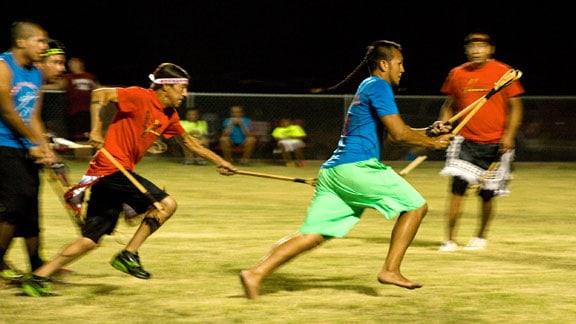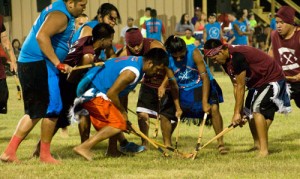
The Roar of Sticks and Spirit: Unearthing the Ancient Rules of Choctaw Stickball, ‘Little Brother of War’
In the heart of the American South, where the whispers of ancient forests meet the modern hum of tribal communities, a game of raw power, spiritual intensity, and profound cultural significance continues to echo through generations. This is Ishtaboli, or Toli, the Choctaw stickball game – often called the "Little Brother of War." More than just a sport, it is a living ritual, a test of endurance, a forge of community bonds, and a sacred link to the Choctaw people’s past. To understand Ishtaboli is to step into a world where athletic prowess intertwines with spiritual preparation, where the rules are as much about honor and tradition as they are about scoring points.
At first glance, a Choctaw stickball game might appear chaotic, a blur of bodies, flying sticks, and a small, elusive ball. But beneath the apparent pandemonium lies a deeply structured set of customs, protocols, and unwritten rules that govern every aspect of the contest, from the sacred pre-game rituals to the brutal on-field clashes. It’s a game where every player is an extension of their community, and every move carries the weight of ancestral expectation.
The Genesis of Conflict and Community: Why Play?

Historically, Ishtaboli served multifaceted purposes far beyond mere entertainment. It was a primary means of settling inter-tribal disputes without resorting to full-scale warfare, hence its moniker, "Little Brother of War." A stickball match could decide land claims, resolve feuds, or even determine the fate of captives. "Our ancestors understood that conflicts were inevitable," explains Cholena Smith, a Choctaw elder and cultural preservationist. "But they also understood the devastating cost of war. Stickball allowed for the release of aggression, a display of strength, and a resolution, all without the complete destruction of a people."
Beyond diplomacy, it was a rigorous training ground for young warriors, honing their agility, strength, strategic thinking, and pain tolerance. It fostered a deep sense of community identity, as entire villages would unite to support their team, investing their pride and their possessions in the outcome. It was also a spiritual endeavor, a way for the Choctaw to honor the Creator and to seek balance and harmony.
The Arena and its Markers: Unconventional Boundaries
Unlike modern sports with meticulously measured fields, the traditional Choctaw stickball ground, or pukoli, was often vast and unmarked. Games could stretch for miles, played across open fields, through forests, and over streams. There were no sidelines or out-of-bounds rules in the conventional sense; the natural landscape served as the playing field.
The goals, known as osi, were the only fixed markers. These typically consisted of two tall wooden posts, often 10 to 15 feet high, planted 15 to 20 feet apart at opposite ends of the playing area. These posts were usually made from sturdy timber, sometimes adorned with tribal symbols or colored ribbons, signifying their importance as the targets for scoring. The objective was simple: to propel the ball into or against the opponent’s osi.
The Tools of the Trade: Sticks and the Sacred Ball
At the heart of the game are its unique implements:
-
The Sticks (Kapucha): Each player wields two sticks, one in each hand. Traditionally crafted from resilient hickory, oak, or other strong native woods, these sticks are roughly three feet long. One end is bent into a scoop or cup-like shape, often reinforced with a small net or rawhide lacing, forming a small pocket. This pocket is crucial for cradling, carrying, and throwing the ball. The sticks are not just tools; they are extensions of the player’s will and skill, requiring immense dexterity to maneuver simultaneously. The craftsmanship of the kapucha was a revered skill, passed down through generations, with each stick embodying the spirit of the wood and the player.
-
The Ball (Towa): The towa is surprisingly small, roughly the size of a golf ball or slightly larger, and historically made from deerskin tightly packed with deer hair, moss, or even clay. Its small size makes it challenging to control and easily lost in the rough-and-tumble of the game, adding to the intensity and requiring precise stickwork. The towa was often imbued with spiritual significance, sometimes blessed by medicine men before a game.

The Players: A Confluence of Warriors and Community
Historically, stickball was predominantly a male sport, with teams numbering from 25 to 50 players per side, and in epic inter-tribal matches, potentially hundreds. Players were typically young, strong men, though elders and seasoned warriors often participated, lending their experience. Teams represented towns, clans, or entire tribal nations.
In modern times, while the men’s game remains a cornerstone, women’s stickball teams (Ainukoa) have also emerged, playing with similar intensity and skill, albeit sometimes with slightly modified rules focusing more on stick-handling than full-contact tackling. Youth leagues also thrive, ensuring the tradition is passed down.
Players wore minimal clothing, often just a breechcloth, reflecting the game’s brutal physicality and the absence of modern protective gear. Their bodies were their armor, and their endurance was their shield.
The Sacred Pre-Game Rituals: Beyond Physical Preparation
Perhaps the most compelling and culturally rich aspect of Choctaw stickball is the elaborate and often secret pre-game rituals. These preparations were not merely physical training; they were deeply spiritual undertakings designed to purify the players, invoke spiritual assistance, and psychologically intimidate opponents.
-
Fasting and Abstinence: Players would fast for days before a major game, abstaining from food, water, and sexual activity. This practice was believed to cleanse the body and spirit, enhancing focus and stamina.
-
Herbal Medicines and Cleansing: Medicine men, or Alypa, played a central role. They would administer special herbal concoctions, often bitter and potent, designed to purify the players, strengthen their bodies, and ward off evil spirits or bad luck. Players might be "scratched" with sharp implements or thorny plants, a painful ritual believed to release bad blood and make them tougher and less susceptible to injury.
-
Vigils and Dances: The nights leading up to the game were often filled with vigils, communal dances, drumming, and chanting. These ceremonies were meant to build team unity, invoke ancestral spirits, and create a powerful spiritual aura around the players. The Stomp Dance, a traditional Choctaw social dance, often featured prominently, its rhythmic steps and calls building collective energy.
-
Psychological Warfare: While not a "rule" in the conventional sense, the pre-game period was also a time for psychological warfare. Teams would often camp near each other, engaging in ritualistic taunting, boasting, and displays of strength designed to intimidate the opposition. This was part of the game’s mental battle, as crucial as the physical one.
The Rules of Engagement: A Dance of Power and Precision
Once the sacred preparations were complete and the sun rose on game day, the rules of play, while seemingly simple, governed a complex and often violent ballet:
-
The Start: The game typically began with the ball placed in the center of the field, often on a raised mound or simply on the ground. Players from both sides would rush forward in a scrum, each attempting to gain possession with their sticks.
-
Objective and Scoring: The primary objective was to move the towa (ball) towards the opponent’s goal posts (osi). Scoring was achieved by hitting one of the opponent’s posts with the ball, or in some variations, carrying it between them, or through a designated scoring zone beyond the posts. Each successful score earned a point, and games were played to a predetermined score (e.g., 100 points) or until sunset.
-
No Hands!: This is perhaps the most fundamental and strictly enforced rule: players absolutely could not touch the ball with their hands. All manipulation of the towa – carrying, scooping, throwing, passing, or blocking – had to be done exclusively with the kapucha. Any deliberate use of hands to control the ball resulted in a foul, often leading to loss of possession or a penalty.
-
Physicality and Tackling: Ishtaboli is an intensely physical sport. Tackling, body checking, pushing, pulling, and even throwing opponents to the ground were not only allowed but expected. There were no pads, helmets, or protective gear. Injuries were common, from broken bones to concussions, and were often viewed as a testament to a player’s courage and dedication. The game was a test of brute strength, agility, and the ability to withstand pain.
-
No Throwing Sticks: While players could use their sticks to block opponents and dislodge the ball, intentionally throwing a stick at another player was generally forbidden and considered a serious foul.
-
Fouls and Penalties: Beyond the "no hands" and "no thrown sticks" rules, other fouls might include excessive intentional injury (though accidental injury was accepted), or blatant disregard for the game’s spirit. Penalties varied but could include loss of possession, a free shot for the opposing team, or in severe cases, removal of a player from the game. Elders and designated "stickball doctors" or referees oversaw the game, their word being final.
-
Duration and Endurance: Games could last for hours, sometimes even days, until the predetermined score was reached or until one side was utterly exhausted. The sheer endurance required was immense, a true test of human limits.
The Wagers: Adding Stakes to the Game
A critical, often overlooked, aspect of historical stickball was the massive amount of gambling that surrounded it. Entire communities would wager their possessions on the outcome – horses, blankets, tools, furs, even land and family heirlooms. This amplified the intensity of the game, making every point, every hit, every save a matter of profound financial and social consequence for the players and their kin. The stakes were incredibly high, transforming a sporting contest into a community-wide investment.
The Aftermath: Healing and Harmony
Once the final point was scored and a victor declared, the spirit of reconciliation often took over. Despite the brutality of the game and the high stakes, the post-game period was crucial for healing and re-establishing harmony. Medicine men would tend to the injured players, using traditional remedies. Feasting and social gatherings followed, allowing both victors and vanquished to share food, camaraderie, and stories, reinforcing community bonds that transcended the competition. The game, having served its purpose, gave way to peace.
Ishtaboli Today: A Living Legacy
In the modern era, Choctaw stickball continues to thrive, particularly within the Choctaw Nation of Oklahoma and the Mississippi Band of Choctaw Indians. While some adaptations have been made for safety and contemporary tournament play (e.g., smaller fields, specific time limits, more defined rules), the core spirit, the dual sticks, the small ball, and the fierce physicality remain.
The game is no longer played to settle inter-tribal wars, but its significance as a cultural touchstone has only grown. It is a powerful tool for cultural preservation, teaching younger generations about their heritage, resilience, and the values of community, honor, and respect. Annual stickball tournaments draw large crowds, celebrating not just athletic prowess but the enduring spirit of the Choctaw people.
"When we play Ishtaboli today, we’re not just playing a game," says a young Choctaw stickball player. "We’re honoring our ancestors. We’re keeping our language alive through the chants, our traditions alive through the rituals, and our spirit strong through the competition. It’s more than just a sport; it’s who we are."
From the ancient battlefields of diplomacy to the modern fields of cultural revitalization, the Choctaw stickball game stands as a testament to a people’s strength, ingenuity, and profound connection to their past. Its rules, both written and unwritten, are a living testament to a way of life where the physical and the spiritual are inextricably linked, and where the "Little Brother of War" continues to teach lessons of peace, endurance, and community.


